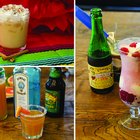Stockphoto24/iStock/GettyImages
By the 1950s, the cocktail had thoroughly permeated American society. Post-WWII soldiers had returned with tales of tropical rum drinks, and gin martinis became all the rage. Although the Manhattan and the
Although today's martinis are made with anything from chocolate liquor to vodka and pomegranate juice, the original cocktail was made only with gin and dry vermouth with a green olive on a fancy toothpick for garnish. The less vermouth, the drier the martini; some said one should only wave the vermouth bottle over the shaker. Switch out the olive for pickled pearl onions and you have a Gibson. Vermouth -- sweet, not dry -- is also a key ingredient in another classic that turns up in old movies: the rye whiskey-based Manhattan. Gin with lemon juice and sugar creates the Tom Collins, a popular summer cooler.
The 1956 Andrews Sisters hit song "Rum and Coca Cola" was a nod to the post-war popularity of rum, which inspired the Cuba Libre, a simple combination of cola and lime. When Polynesian tiki restaurants took off, tropical drinks with umbrellas began a long run of popularity. The Trader Vic's mai tai, made with light rum, orange liqueur, almond syrup, fresh lime juice and rock candy syrup, turned up at cocktail parties alongside the teeny weenies and the bacon-wrapped water chestnuts known as
As co-ed drinking came into vogue, many of the cocktails were designed to attract women. The sumptuous creme de menthe and creme de cacao grasshopper was sometimes blended with ice cream, like a green alcoholic milkshake, and the sweet and fruity sloe gin fizz might as well have come from a soda fountain tap. The simplest of all was the white Russian, a simple mixture of vodka, Kahlua and cream. These drinks were often served either with or in place of dessert.
As the weekend brunch became popular as social gatherings in homes and restaurants, drinks began to take on a healthy disguise. A stick of celery and a couple of olives added to tomato juice and vodka made the bloody Mary cocktail practically a food group of its own. The screwdriver -- simply orange juice and vodka -- provided a good dose of vitamin C, as did its grapefruit juice cousin, the greyhound. Once only known in New Orleans, the elaborate and airy Ramos gin fizz made a comeback for brunch events.
Related Articles

The Popular Mixed Drinks of the 50s & ...

Most Popular Drinks of the 1970s

The Cocktails Invented in the 1920s

What Drinks Can I Make With Banana Rum?

What Drinks Can You Make With Black ...

What Do You Mix Grappa With?

What Kind of Mixed Drinks Can I Make ...

What Liquor Do You Mix With Eggnog?

How to Mix Liquor With Fresh Fruit & ...

Desserts From the '20s

Mixed Drinks Using Blue Curacao & ...

What Is Good to Mix With Chocolate ...

What Kind of Mixed Drinks Taste Like ...

Good Chasers to Mix With Vanilla Vodka

10 Beer Cocktail Recipes You Need to Try

What Drink Can You Make With Vodka, ...

What Is a Tiki Party?

What Soda Do You Use With Whipped Cream ...

Party Theme Ideas: 1969

Can You Make Vodka Pina Coladas?